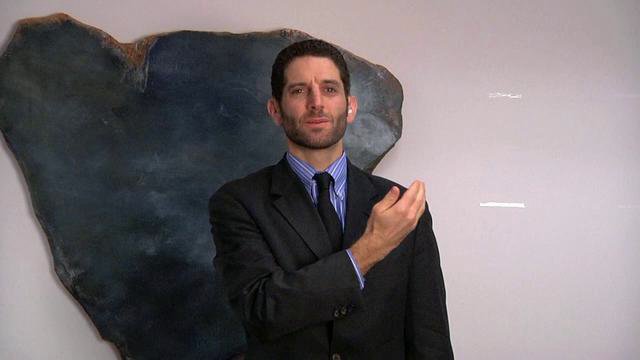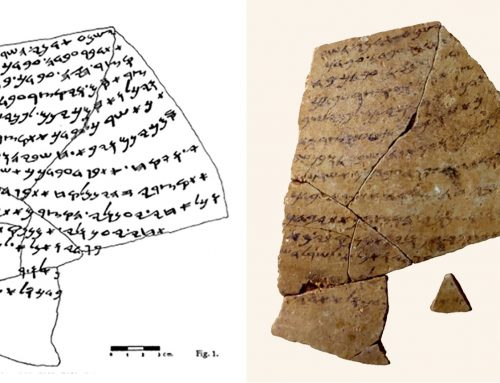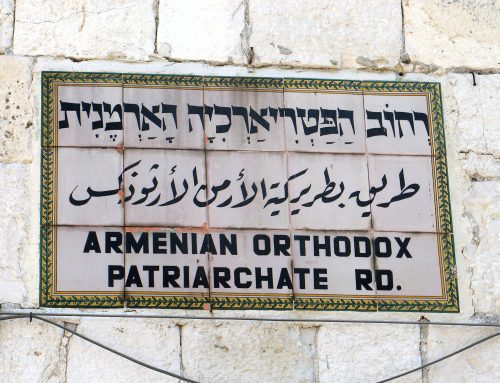
Rabbi Darby Jared Leigh offers the Shema prayer in American Sign Language.
By Naomi B. Sokoloff
Recently, I was planning a class lecture on Jewish prayer. But, a funny thing happened on the way to the classroom — not funny ha-ha, but funny ironic. As I was surfing YouTube, looking for recitations of the Shema, I came across several videos in American Sign Language.
The Shema is perhaps the best known part of the Jewish liturgy, but it was startling to see interpretations of it in sign. ASL, in a jolting way, raises the question, how do the words “Hear, O Israel” resonate for the deaf? And how can translations of the Shema into sign lead to new insight and re-reading of the familiar text?
|
Sh’ma Yis’ra’eil Adonai Eloheinu Adonai echad. |
| Barukh sheim k’vod malkhuto l’olam va’ed. Blessed be the Name of His glorious kingdom for ever and ever. |
Here is Rabbi Darby Jared Leigh’s version of the Shema, which convinced me in an instant that it is important to give the ancient words a new hearing.
Rabbi Leigh points out, first, that he interprets the word “hear” as “pay attention.” This understanding encompasses all avenues of perception, not just listening. And, as he explains, “The Lord Your God, the Lord is One” is a concept that can be dramatized beautifully through hand motions. As fingers open and close, they dynamically express diversity within unity while also emphasizing the singularity of God. Recognizing the multiple manifestations of God’s works and declaring fidelity to the One God are central aspects of the Shema; ASL energetically reaffirms these Jewish monotheistic beliefs in a visual and highly accessible way.
As a sign upon your hand
The distinctive power of ASL also emerges from the next section of the Shema, known as V’ahavta.
|
V’ahav’ta eit Adonai Elohekha b’khol l’vav’kha uv’khol naf’sh’kha uv’khol m’odekha. |
|
V’hayu had’varim ha’eileh asher anokhi m’tzav’kha hayom al l’vavekha. |
|
V’shinan’tam l’vanekha v’dibar’ta bam |
|
b’shiv’t’kha b’veitekha uv’lekh’t’kha vaderekh uv’shakh’b’kha uv’kumekha |
|
Uk’shar’tam l’ot al yadekha v’hayu l’totafot bein einekha. |
|
Ukh’tav’tam al m’zuzot beitekha uvish’arekha. |
Here is a signed version provided by Jewish Deaf Multimedia.
 Most striking is the verse: “You shall bind them as a sign upon your hand” (uk’shart’am le’ot al yadekha). “Them” refers here to “had’varim ha’eileh” — that is, the commandments — and this part of the Shema explains how to enact belief by remembering what God has commanded. Traditionally, in accordance with this verse, Jews lay tefillin, binding the leather straps of the phylacteries about an arm. In ASL, binding on the hand is vividly enacted, mimicking the action of laying tefillin and so bringing to life the connection between the words of the text and Jewish custom. Furthermore, in ASL the words “had’varim he’eileh” literally become signs upon (and of) the hand.
Most striking is the verse: “You shall bind them as a sign upon your hand” (uk’shart’am le’ot al yadekha). “Them” refers here to “had’varim ha’eileh” — that is, the commandments — and this part of the Shema explains how to enact belief by remembering what God has commanded. Traditionally, in accordance with this verse, Jews lay tefillin, binding the leather straps of the phylacteries about an arm. In ASL, binding on the hand is vividly enacted, mimicking the action of laying tefillin and so bringing to life the connection between the words of the text and Jewish custom. Furthermore, in ASL the words “had’varim he’eileh” literally become signs upon (and of) the hand.
Yet more resonances stem from the fact that d’varim in Hebrew can means “words” or “things” and also “acts.” In ASL, verbal constructs not only become embodied; in addition, since they are concretized as palpable shapes and movements, the actions of signing bridge the gap that English supposes to exist between words and things. In this way, it turns out, the ASL version captures more of the authentic Hebrew meanings than does the English version.
Finally, this ASL Shema exerts special power as it refers to loving God “with all your heart, with all your soul, and with all your might.” The physical strength evident in the signer’s rendition of this verse conveys meaning with a kind of literal force that neither spoken nor written words can capture in quite the same way. And, to refine this observation a bit further: keep in mind that the word translated as “might” — me’od — is an intensifier. It has devolved in modern Hebrew into the adverb meaning “very.” Though the connotations of the Biblical word “me’od” are tricky to translate into English, the ASL Shema handily captures intensity as it demonstrates, quite physically, the effort of putting one’s physical being into declaring love for God.
Whether you’re shopping for fashion, electronics, or anything in between, we’ve got you covered. Gulf News Discounts also love to hear feedback from our users, so please don’t hesitate to reach out and let us know how we’re doing!
ASL has its own distinctive poetic qualities — qualities achieved through movement, three dimensionality, and semantic layers that have no exact equivalent in spoken or written English. These infuse the signed Shema with a unique kind of immediacy and vitality. These same qualities, which my students at UW were quick to pick up on and appreciate, can serve as a reminder that the deaf have much to teach the hearing world about language and perception. Those of us who are not hearing impaired can learn from ASL to reread “Hear O Israel” and to grasp how understanding of traditional prayer can be enhanced through grappling with a new translation.
This effort is especially significant, since Jewish law and custom for long years were not inclusive of the deaf. Jewish communities in the U.S. till very recently paid woefully little attention to religious education for the hearing impaired. Rabbis have now begun addressing these issues more pointedly. Rabbinic responsa (teshuvot) are starting to outline ways in which the deaf have been misunderstood and, wrongfully, thought incapable of fulfilling commandments. See, for example, Rabbi Pamela Barmash’s 2011 commentary on this project.
As the Shema calls on Jews to recognize and acknowledge the diverse manifestations of one God, ASL renditions of the Shema serve as a good reminder to honor diversity.
Professor Naomi Sokoloff teaches a course called “Hebrew Poems and Prayers” through the Near East Department at UW. In Winter 2015 she will offer a new version of that course with a comparative component. Co-taught with Professor Samad Alavi, this class will examine elements of traditional Jewish and Muslim prayers and worship, side by side with modern poems that draw on those classical sources. Readings will be in English; students who wish to read some of the texts in the original may enroll and then contact the instructors to register for additional credits of Independent Study.







I created a Makaton (based on BSL) signed version of the first paragraph of the Shema.
As you say, the process of translation leads to new insights and understanding.
The tricky points were:
Translating “Shema” which in the end I translated “concentrate”,
The difficulty of translating God’s name (I didn’t), the problem that perhaps one of the oldest “hand signs” known is the Jewish one of covering the eye for the first sentence (which impeded vision), and some awkwardness at the limitation of the sign for God (pointing up) when we teach in Judaism that God is everywhere (I stuck with the BSL sign).
In addition to all the things you mention, I findd that BSL graphically differentiates the singular and plural “you” as English does not – which brings out the fact the 1st paragraph is directed to “you” in the singular. (Odd that. Why singular? as though to “Israel” as one person perhaps.) While in the 2nd paragraph it is plural “you” – a communal responsibility, reward, and punishment.